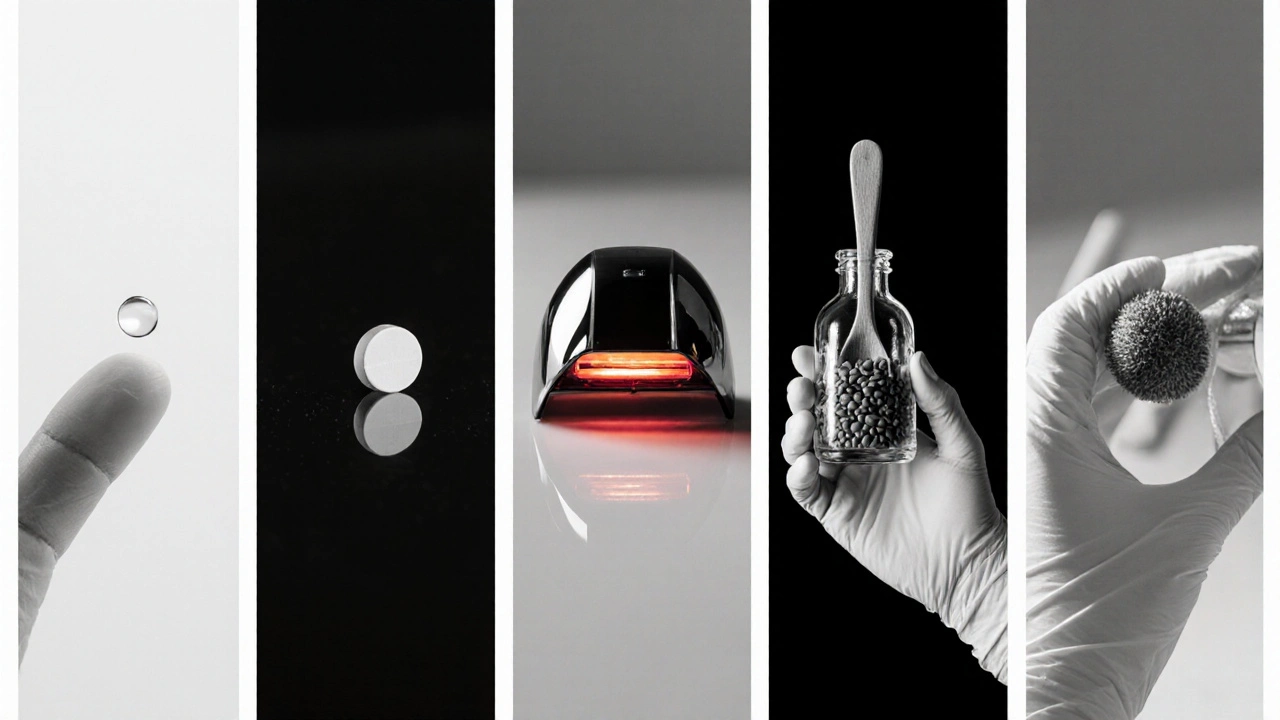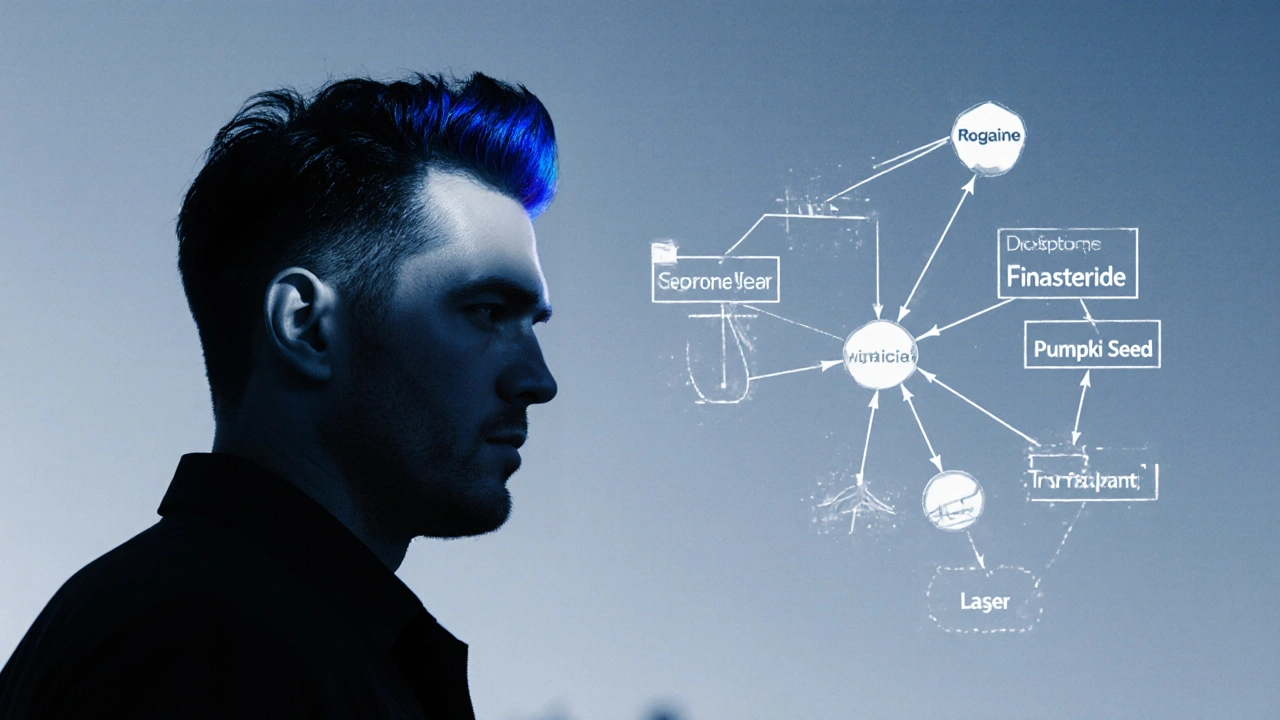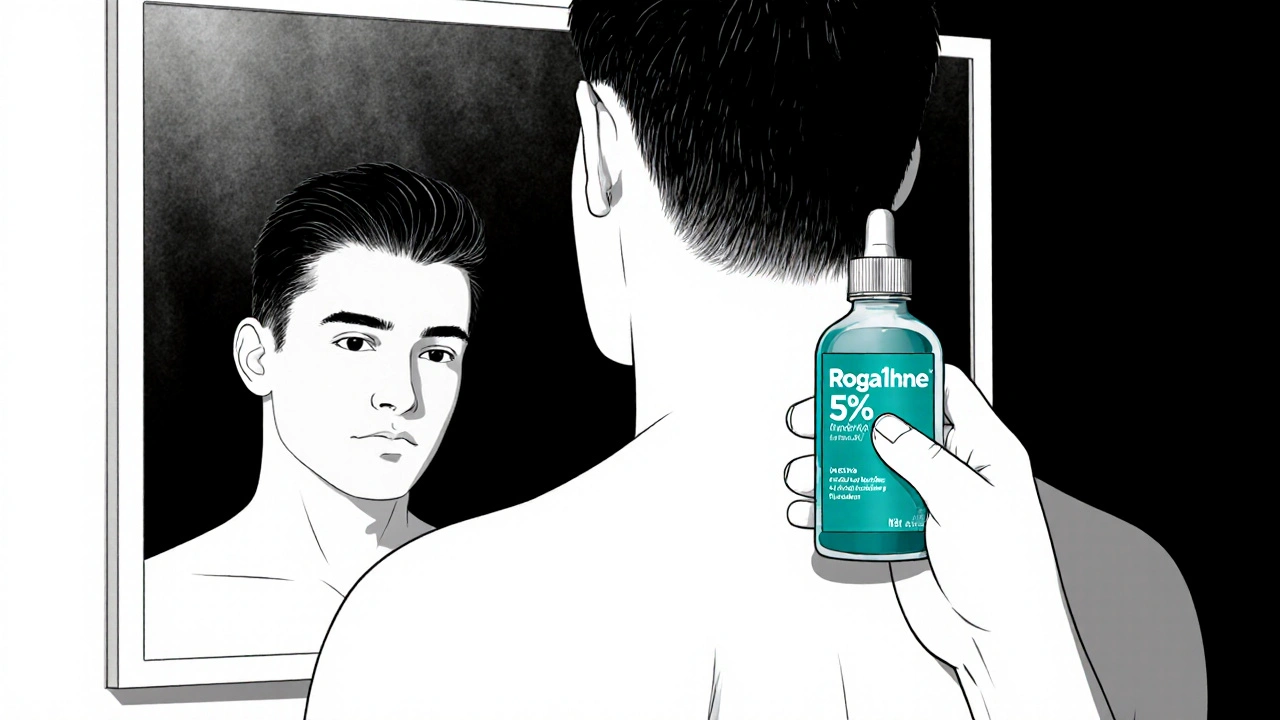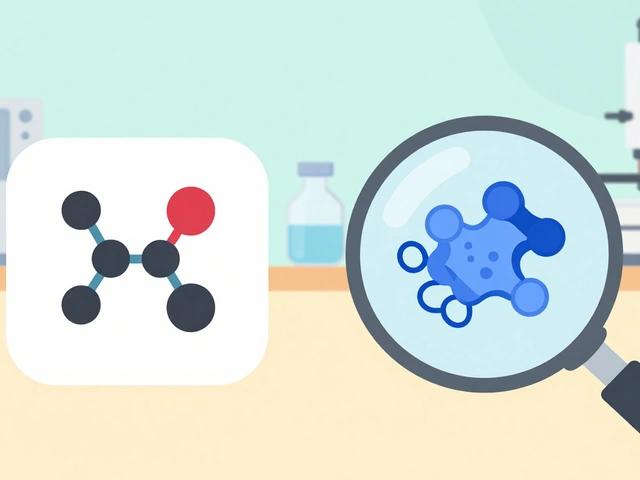Hair Loss Treatment Cost-Effectiveness Calculator
Personalize Your Treatment Analysis
Personalized Treatment Recommendations
Rogaine 5% Minoxidil
Cost over 6 months: $60-$90
Estimated effectiveness: 30-45%
Common side effects: Scalp irritation, temporary shedding
Best for mild to moderate thinning with DIY approach
Finasteride (1mg)
Cost over 6 months: $60-$140
Estimated effectiveness: 65-90%
Common side effects: Sexual dysfunction, mood changes
Best for male pattern baldness with hormonal control needs
LLLT Device
Cost over 6 months: $40-$100
Estimated effectiveness: 45-55%
Common side effects: Eye strain (if not protected)
Best for tech-savvy users preferring non-chemical options
Pumpkin Seed Oil
Cost over 6 months: $30-$90
Estimated effectiveness: ~30%
Common side effects: Digestive upset (rare)
Best for budget-conscious natural product fans
Hair loss can feel like a personal crisis, especially when you see more scalp than hair each morning. You’ve probably Googled "best hair regrowth" and landed on Rogaine, the over‑the‑counter minoxidil product that promises thicker strands. But is Rogaine truly the top choice, or are there cheaper, safer, or more effective alternatives? This guide breaks down the science, cost, and real‑world results so you can decide which option fits your budget and lifestyle.
Rogaine 5% Minoxidil is a topical solution that contains the FDA‑approved active ingredient minoxidil, originally developed as a hypertension drug before its hair‑growth side effect was discovered in the 1980s. The 5% concentration is the most widely sold strength for men, while a 2% version exists for women. Applied twice daily to the scalp, it works by widening blood vessels, increasing oxygen and nutrient delivery to hair follicles, and extending the anagen (growth) phase of the hair cycle.
How We Compare Hair‑Loss Products
- Mechanism of action: Does it address hormone‑related loss, improve blood flow, or stimulate follicles directly?
- Clinical effectiveness: What percentage of users see measurable regrowth in controlled studies?
- Onset of results: How many weeks before a visible difference appears?
- Side‑effect profile: Frequency and severity of irritation, systemic effects, or other risks.
- Cost per month: Real‑world pricing after discounts or insurance.
- Ease of use: Daily routine, need for prescription, or professional visits.
Alternative #1: Finasteride (Oral)
Finasteride (brand name Propecia for the 1mg dose) is a prescription‑only pill that blocks the conversion of testosterone to dihydrotestosterone (DHT), the hormone largely responsible for male‑pattern baldness. Clinical trials show up to 90% of men experience a slowdown in hair loss, and roughly 65% report new growth after 12months.
- Pros: Strong evidence, works systemically, convenient once‑daily pill.
- Cons: Possible sexual side effects, requires a prescription, not approved for women.
- Typical cost: $30‑$70 per month, often covered by insurance for BPH dosing.
Alternative #2: Low‑Level Laser Therapy (LLLT)
Low‑Level Laser Therapy devices - ranging from handheld combs to full‑head caps - emit red light (630‑670nm) that stimulates cellular metabolism in hair follicles. Studies published in the Journal of Dermatological Science report a 45‑55% improvement in hair density after 24 weeks of twice‑weekly use.
- Pros: Non‑invasive, no chemicals, can be used alongside other treatments.
- Cons: High upfront price ($200‑$1,200), results vary, requires consistent use.
- Typical cost: One‑time purchase; amortized to $20‑$50 per month over two years.
Alternative #3: Pumpkin Seed Oil (Natural)
Pumpkin seed oil is a cold‑pressed oil rich in phytosterols, which are thought to inhibit 5‑α‑reductase activity similarly to finasteride, but with far milder systemic effects. A 2014 double‑blind trial with 76 men found that 32% of participants taking 400mg daily experienced a modest increase in hair count versus 0% in the placebo group.
- Pros: Affordable, easy to ingest, minimal side effects.
- Cons: Weaker evidence, slower onset (4‑6months), dosage not standardized.
- Typical cost: $15‑$30 for a month’s supply.

Alternative #4: Hair Transplant Surgery
Hair transplant (Follicular Unit Extraction or Follicular Unit Transplant) physically moves healthy follicles from a donor area (usually the back of the scalp) to thinning zones. The transplanted hairs retain their original growth cycle, offering a permanent solution for suitable candidates.
- Pros: Permanent, natural‑looking results, high patient satisfaction.
- Cons: Expensive ($4,000‑$15,000 per session), requires surgical expertise, not ideal for extensive loss.
- Typical cost: $3,000‑$10,000 depending on graft count.
Side‑Effect Snapshot for Rogaine 5% Minoxidil
While many users tolerate Rogaine well, common complaints include scalp itching, dryness, and a brief shedding phase when treatment begins. Rarely, systemic absorption can cause low‑blood‑pressure symptoms, especially if used on large areas. The key is to start with a small amount, observe any irritation, and adjust the application frequency.
Quick Decision Guide
| Product | Type | Clinical Effectiveness* | Typical Monthly Cost | Common Side Effects | Best For |
|---|---|---|---|---|---|
| Rogaine 5% Minoxidil | Topical solution | 30‑45% noticeable regrowth | $30‑$45 | Scalp irritation, shedding | Early‑stage thinning, DIY users |
| Finasteride (1mg) | Oral prescription | 65‑90% slowed loss, 40‑60% new growth | $30‑$70 | Sexual dysfunction, mood changes | Male‑pattern baldness, motivated for hormonal control |
| Low‑Level Laser Therapy | Device (light) | 45‑55% density increase | $20‑$50 (amortized) | Eye strain (if not protected) | Those preferring non‑chemical, tech‑savvy users |
| Pumpkin Seed Oil | Oral supplement | ~30% modest growth | $15‑$30 | Digestive upset (rare) | Budget‑conscious, natural‑product fans |
| Hair Transplant | Surgical | Permanent 80‑95% graft survival | $3,000‑$10,000 (one‑time) | Post‑op pain, scarring | Advanced loss, long‑term investors |
*Effectiveness percentages are drawn from peer‑reviewed studies and real‑world surveys up to 2024.

Practical Tips to Maximize Results
- Combine treatments only after consulting a dermatologist - for example, minoxidil + finasteride is a popular, evidence‑based combo.
- Apply Rogaine to dry scalp, let it absorb for at least 2hours before styling.
- Be patient: most products need 12‑24weeks of consistent use before you can judge success.
- Track progress with weekly photos; tiny changes become clear over months.
- Maintain a healthy diet rich in iron, biotin, and omega‑3 fatty acids - they support follicle health.
When to See a Professional
If you notice rapid shedding, scalp pain, or if your hair loss pattern changes dramatically, schedule a visit with a board‑certified dermatologist or trichologist. They can run a scalp biopsy, blood hormone panel, or diagnose conditions like alopecia areata that require different therapies.
Frequently Asked Questions
How long does it take to see results with Rogaine?
Most users notice a reduction in shedding after 4‑6weeks, but visible thickening typically appears after 12‑16weeks of twice‑daily use.
Can I use Rogaine and Finasteride together?
Yes - many clinicians prescribe the combo because they work through different pathways. Monitor for increased scalp irritation and discuss any side effects with your doctor.
Are natural alternatives like pumpkin seed oil effective?
Research suggests modest benefits for early‑stage thinning, especially when combined with a good diet. They’re not a substitute for FDA‑approved meds in advanced loss.
What are the risks of low‑level laser therapy?
The main concern is eye exposure; always wear the provided goggles. Otherwise, the treatment is considered safe with minimal skin irritation.
Is a hair transplant a permanent fix?
Transplanted follicles are genetically resistant to DHT, so they grow permanently. However, native hairs can continue to thin, so many doctors recommend continuing medical therapy after surgery.
Whether you stick with the classic Rogaine vs alternatives route or blend several methods, the key is consistency and realistic expectations. Hair regrowth rarely happens overnight, but with the right plan you can keep more of your existing hair and possibly add new strands. Start with a clear goal, pick the option that matches your budget and health profile, and give it the time it deserves.







Hair is more than a collection of follicles; it’s a living flag of identity, especially when we wave it under the stars and stripes. The chemistry of minoxidil may open pores, but the spirit that drives us to keep fighting baldness is unmistakably American. If a product can keep your scalp covered, it also preserves the confidence that fuels our daily hustle. So weigh the science, but never forget the pride that comes with a full head of hair.
When you peel back the glossy veneer of a commercial like Rogaine, you uncover a cascade of decisions that ripple through every facet of one’s existence. The first ripple begins at the scalp, where the 5% solution seeps into pores like a gentle tide, coaxing dormant follicles back into the anagen phase while simultaneously demanding a ritualistic twice‑daily schedule that can dominate morning and night routines alike. The second ripple surges into the wallet, as the recurring expense of $30 to $45 per month slowly erodes disposable income, especially when compounded by the need for a steady supply to avoid the dreaded “shedding” rebound. The third ripple is psychological: each drop applied becomes an affirmation of hope, a tiny act of defiance against the inexorable march of genetics, and yet it also plants a seed of anxiety about compliance and visible results. The fourth ripple spreads to social interactions, because the mere act of explaining a damp patch on your forehead often triggers a cascade of curiosity, skepticism, or unsolicited advice from strangers and friends. The fifth ripple infiltrates the bedroom, as the lingering scent of the solution can mingle with sweat and perfume, inadvertently marking a personal space with the subtle aura of a medical regimen. The sixth ripple touches the skin itself, where irritation, itching, and occasional dryness can provoke a primal discomfort that forces you to choose between perseverance and relief. The seventh ripple reaches your schedule, demanding that you plan showers and styling around the mandatory absorption window, lest you dilute the efficacy with hair products too soon. The eighth ripple seeps into your future, because the results, typically visible only after twelve to sixteen weeks, require an unwavering patience that tests even the most disciplined individual. The ninth ripple, perhaps the most overlooked, is the environmental one: the plastic bottles, the chemical runoff, and the carbon footprint of manufacturing and shipping a product that many users consume for years on end. The tenth ripple, however, is a silver lining: when the regimen finally bears fruit, the regrowth not only restores a visual canopy but also revitalizes self‑esteem, encouraging a cascade of positive behaviors in other domains of life. Each of these ripples interlocks, forming a complex tapestry that transforms a simple over‑the‑counter bottle into a multifaceted lifestyle decision, one that deserves careful contemplation far beyond the superficial promise of “thicker hair.” Moreover, the communal narratives that evolve around minoxidil users create support networks that can alleviate the isolation often felt during hair‑loss journeys. Additionally, the interplay between Rogaine and adjunct therapies, such as finasteride or low‑level laser devices, opens a combinatorial frontier that can amplify outcomes when managed wisely. Ultimately, the decision to adopt Rogaine is less about a single product and more about committing to a holistic strategy that acknowledges the biological, emotional, and social dimensions of hair restoration.
Everyone waxes lyrical about minoxidil’s miracles, but the data quietly whisper that many users never see a discernible thickening, and the placebo effect can masquerade as success 😊. In fact, the sheer variability in individual response makes it hard to brand any over‑the‑counter serum as a universal remedy.
🤔 While you clutch at stats, remember that a nation’s vigor isn’t measured by hair follicles alone, yet the patriotic pride in “Made in USA” formulas does give an extra boost of confidence. 🌟
keep it simple-stay consistent and watch the change.
Oh, the journey of a strand is a saga worthy of epic poetry! When you honor the routine with the devotion of a knight guarding his kingdom, the scalp rewards you with a crown of renewed vigor, and every emerging follicle becomes a shining beacon of perseverance that lights the path for anyone daring to confront the tide of thinning.
Consider hair as a metaphor for resilience: each tiny filament that returns after a season of dormancy testifies that growth, once seeded, can flourish even after the harshest winter, provided we nurture it with patience, science, and a touch of hope.
yeah i hear u its cool to see people share tips we can all learn from each other dont forget to post your pics later
costs add up fast and the itch factor is real.
in many cultures hair holds sacred meaning, so *using* a prescription that was once a blood pressure drug feels like borrowing a hero’s potion, weaving science with tradition in a way that transcends mere vanity.
what they don’t tell you is that the big pharma giants are secretly engineering the next wave of “hair‑loss” products to keep us dependent, funneling profits while they quietly manipulate the very genes that dictate follicle health.
oh sure, because trusting a multinational corporation with your scalp is the epitome of moral virtue, right?
maybe the hype is just noise.